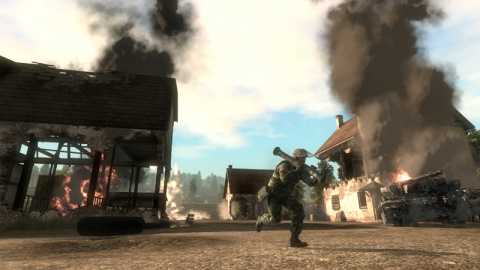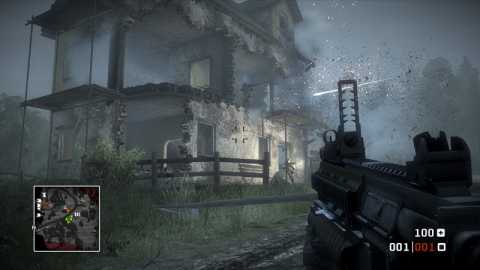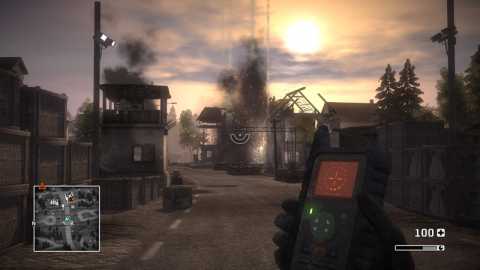Lots of games have explosions--with all the conflict and war being represented on various video game machines these days, I'd almost be willing to wager that there are more games that have explosions than games that don't. As a result, most standard destruction has become passe. Punching an exploding barrel just doesn't have the same thrill that it once did. That's why someone is always out there, working in secret on games that give explosions the respect they deserve. Sometimes, though, these games focus too much on the explosion, and the gameplay suffers as a result. So it's nice when all this stuff can co-exist. Battlefield: Bad Company has great-looking bangs, but the reason they're so thrilling is because they do more than just damage all nearby players, enemies, and vehicles. These explosions dig big divots in the environment, knock down fences, and blast holes in the sides of buildings, making them an exciting and useful gameplay addition that helps make the whole game better.

The mercenaries are where the story strays from the standard war tale and presses firmly into "Three Kings without all the messy political messages" territory. It seems that the mercenaries are part of a private army run by a man known as the Legionnaire, who only conducts business when gold is involved. With truckloads of gold around the region, your team quickly eschews duty, goes AWOL, and gets into the gold hunting business. The game tells most of its story through in-engine cutscenes, where the members of your team really come alive through a combination of clever dialogue, quality voice acting, and terrific visuals.
It's also neat that Bad Company manages to feel like a Battlefield game while still presenting you with a cohesive story and multiple objectives. With few exceptions, the game takes place on wide-open battlefields. You'll traverse long distances over the course of the game, which really gives it a sense of size and scope that you don't get from most other shooters. That said, there are limits to this wide-open freedom, as the edges of the current area are closed off. If you travel into these darker areas of the map, a five-second timer pops up, and you're killed (by enemy artillery, the game claims) if you stay outside the lines until time expires. That feels a little artificial, but never comes across like a huge restriction.

And that's what makes Battlefield: Bad Company so much fun. Many sections of the game have you working your way through a bunch of small, enemy-filled houses. While you could crawl through windows or look for doors to make your way from one house to the next, it's way faster and way more fun to just blast holes in walls and leave a path of scorched Earth in your wake. While you can't quite take down an entire building, you can blow most walls and roofs completely apart, denying your enemy cover in the process. The devastation is useful and it also looks fantastic, which is a winning combination.
The dynamic destruction of Bad Company also carries over to the multiplayer side. Online, the game becomes a bit more traditional, offering a style of class-based multiplayer with unlockable weapons for each class. While you could argue that playing with preset classes in a post-Call of Duty 4 world is a bit dated, the differences between the classes are meaningful and interesting. Even the support class, which does double duty as both a medic and an engineer, is fun to play, largely because he also gets the ability to call in mortar strikes and wields a light machine gun.

It makes for an interesting struggle, and the open areas and vehicle-enabled gameplay that you'd expect to find in a Battlefield game is present, though the vehicle control does take some getting used to. There are plenty of houses and other buildings to hide in or blow up, and overall, the maps feel just right for the 24-player limit.
As you play online ranked matches, you earn experience points that grant you additional ranks. You also earn unlock points when you gain a rank, which you can use to unlock three more items per class--two primary weapons and one special item, such as a health recharger, mortar strike, anti-tank mines, and so on. There are also ten weapons in multiplayer--two per class--that can't be selected under normal circumstances. One set is the gold set, which are given to players who purchase the Gold Edition version of the game for an extra $10. If you don't get this version, you still earn these weapons when you hit the level cap at rank 25.
The other set is a little more insidious, as it requires you to jump through a mess of marketing behavior-oriented hoops. One weapon is earned for pre-ordering the game (so if you're reading this and thinking about buying the game, it's already too late). Another you get for signing up for the Bad Company newsletter. Another is earned for playing the demo version of the game and ranking up to level four. The whole thing feels cheap and filthy, though the good news is that these weapons don't really feel very necessary, either. After unlocking every other weapon, you'll have six primary weapons to choose from. While I wasn't able to unlock all of these guns and see them for myself, the statistics given for their accuracy, handling, rate of fire, and so on don't make them sound like must-have equipment.
Between its easy-to-enjoy multiplayer and the romp that is the single-player campaign, Battlefield: Bad Company is an easy game to like. It looks great, has fun characters, a load of interesting weaponry, and works nicely whether you're playing alone or with a squad. The campaign lasts long enough to feel fulfilling, and the multiplayer kept me coming back once that was complete.